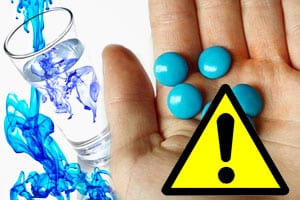
A new study reveals that a common blue dye used in a variety of consumer products, including food, might by harmful to our health. The study appears in the journal Food and Chemical Toxicology. The Slovak University of Technology researchers studied two blue dyes—Patent Blue and Brilliant Blue, said Fox News. Patent Blue is banned […]
 A new study reveals that a common blue dye used in a variety of consumer products, including food, might by harmful to our health. The study appears in the journal Food and Chemical Toxicology.
A new study reveals that a common blue dye used in a variety of consumer products, including food, might by harmful to our health. The study appears in the journal Food and Chemical Toxicology.
The Slovak University of Technology researchers studied two blue dyes—Patent Blue and Brilliant Blue, said Fox News. Patent Blue is banned from food products in the United States; however, Brilliant Blue—FD&C Blue No. 1—is used in food, textiles, leathers, and cosmetics in a number of countries, including in the U.S.
“ is one of the most commonly used blue dyes,” study co-author, Jarmila Hojerová, an associate professor at the Slovak University of Technology and president of the Slovak Society of Cosmetology told Fox News.
Hojerová and her colleagues found that the blue dyes enter the bloodstream through either the skin or digestive tract, which was a surprising finding as it has been largely believed that the skin stopped dye from entering the body and that ingested dye is destroyed by the gastrointestinal system, said Fox News.
Hojerová told Fox News that the findings are troubling given that a number of studies found these dyes might inhibit cell respiration. “If the process of creating energy and respiration does not take place properly, there are many failures,” she noted.
Both blue dyes have been linked to ADHD, allergies, and asthma, said Fox News. In fact, when Brilliant Blue was used as a dye in feeding tubes in 2003, the U.S. Food & Drug Administration (FDA) issued a public health advisory over effects including blue-tinged skin, urine, and feces; hypotension; and death.
Should the skin’s barrier become compromised—such as after shaving or if the dye comes into contact with the mucous membrane of the tongue—the blue dyes can enter the bloodstream. Although more research is needed, the study authors recommend that the dyes be banned in hard candies and certain cosmetic products, said Fox News.
Industry group, the International Association of Color Manufacturers, not unexpectedly, disagreed with the findings, noted Fox News.
As far back as the 1970s, some pediatricians and other children’s advocates have called for the elimination of dyes and preservatives in the diets of children with behavior problems. And, as far back as 1980, clinical studies have linked the dyes to pediatric behavioral problems.
In 2007, a study commissioned by the United Kingdom’s Food Standards Agency, linked hyperactivity in children to artificial colorings, some not used in the U.S., and one food preservative. In the European Union, foods containing artificial food dyes have been required to carry warnings that they may have an “adverse effect on activity and attention in children” since 2008.
The same year the European Union mandated the warning, the U.S.-based group, the Center for Science in the Public Interest (CPSI) urged the FDA to ban eight dyes, including FD&C Blue 1, citing studies linking the dyes to behavioral effects mimicking hyperactivity in children.


